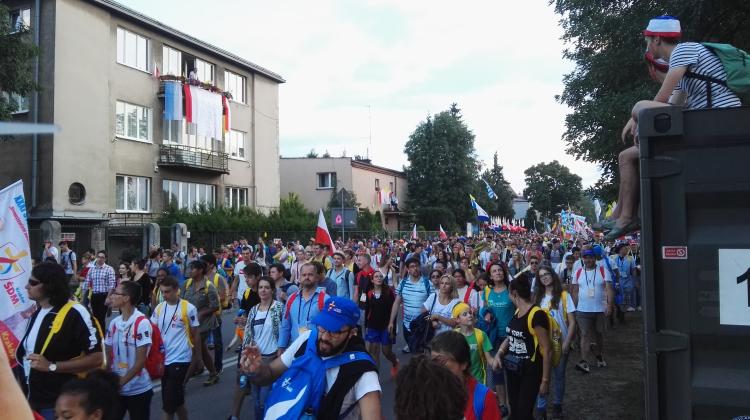Following the crowd? Your movement is governed by four main principles
 An example of one-way traffic during World Youth Day 2016 in Kraków; Credit: Jarosław Wąs
An example of one-way traffic during World Youth Day 2016 in Kraków; Credit: Jarosław Wąs
Leaving a train platform with the crowd? Found yourself in a corridor full of people? Walking through a narrow underground passage? You might not realize it, but your movement is governed by four main principles. They have been identified by IT experts from AGH.
Scientists from AGH have examined how people move in one direction in a narrow corridor. "There are four main principles that govern this movement: 1) Try to follow the person directly in front of you 2) Maintain the fixed distance from that person 3) Do not pay attention to the people on the sides 4) Keep the distance from others that allows to evade the necessity of continuously adjusting your speed to your neighbours" - summarized the main author of the study, Jakub Porzycki, PhD student from the AGH University of Science and Technology in Kraków. The results of this study have been published in Physical Review E (https://link.aps.org/doi/10.1103/PhysRevE.96.022307).
The research results of will allow to prepare better simulations of crowd behaviour. Such knowledge will be useful, for example, for architects in designing safer buildings - especially designing and marking escape routes. It will be useful for firefighters and perhaps those in danger. It could also be used by film studios that create visualizations of movement of large groups of people.
"Our research consisted in developing a model of human movement" - said Dr. Jarosław Wąs from AGH. He added that in some situations it is important to realize that in our behaviour we use specific rules. Especially that it may turn out that in the event of an evacuation these rules are not optimal at all. "It is not always good to follow the crowd. When we have to leave the building quickly, it is better to look around and find escape routes" - said Dr. Wąs. He pointed out that using escape routes can be a better option than following others. "It turns out that some safety exits are not used at all" - the scientist noted.
In the study published in "Physical Review E" the researchers analysed the position of moving people relative to their nearest neighbours. "We also showed the shape of the so-called personal space, the space which we do not allow other pedestrians to enter" - said Jakub Porzycki.
He added that researchers had earlier analysed such a "personal space" for people standing. In that case, that space - or intimate distance - was in the shape of a circle. And that means keeping the same distance from all other people. We keep similar distances to people who are standing in front of us, behind us and on the sides. Porzycki expected that the same would be true for walking people. But it turned out that in this case the personal space was oval shaped. And that means we feel uncomfortable when someone walks too close in front or behind us. "But the people on our sides do not bother us that much. Our personal space is narrower on the sides" - said Porzycki.
Dr. Jarosław Wąs noted that the study of people\'s movement in a corridor is one of a series of studies of crowd physics conducted by researchers from AGH. In previous studies, researchers analysed the behaviour of pedestrians during evacuation of a smoky tunnel (the experiment was conducted in the tunnel under the Martwa Wisła in Gdańsk and the Laliki tunnel on the S1 motorway). Crowd movement at several stadiums was also analysed - including GKS Tychy stadium. "In Poland, simulations of crowd behaviour are still too rarely taken into account at the design stage of buildings and infrastructures" - added the scientist.
PAP - Science and Scholarship in Poland, Ludwika Tomala
lt/ zan/ kap/
tr. RL
Przed dodaniem komentarza prosimy o zapoznanie z Regulaminem forum serwisu Nauka w Polsce.

















